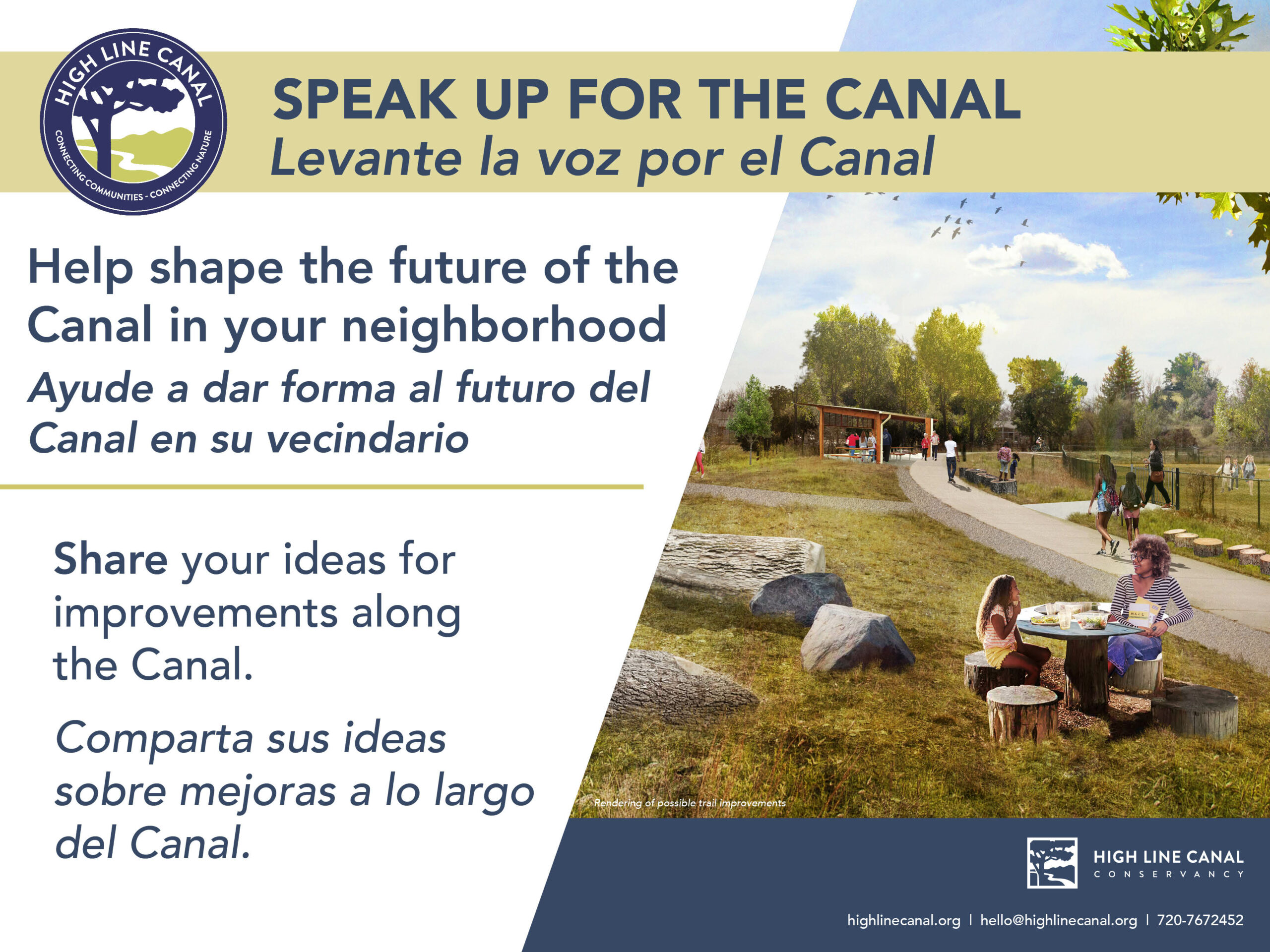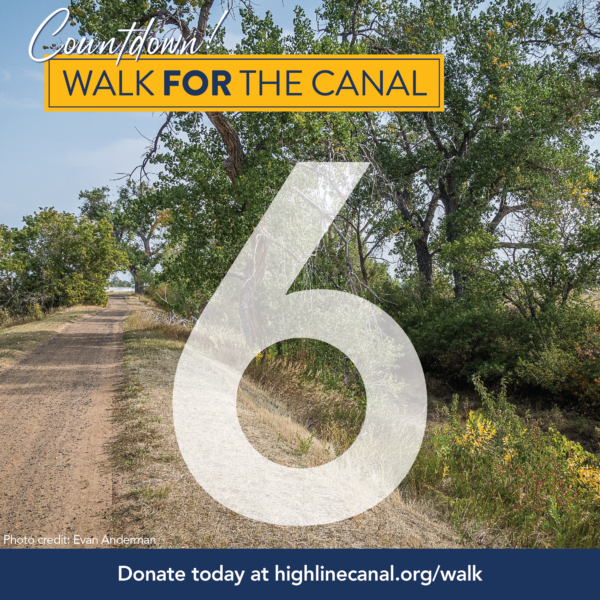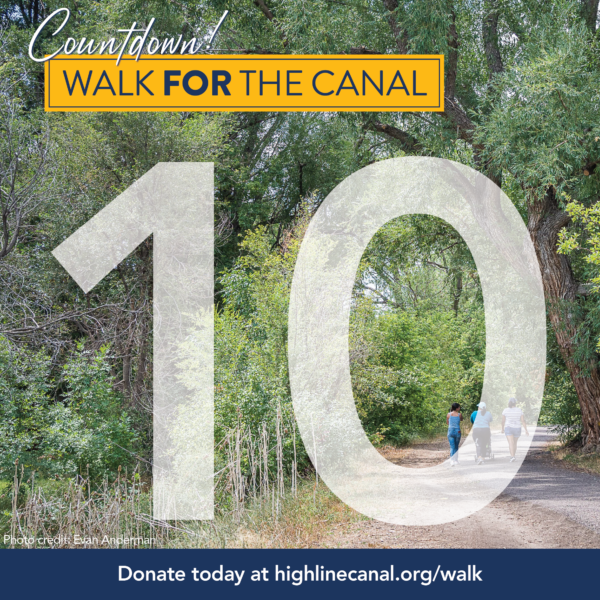Welcome back, everyone! This is the second and final part of our blog series on the U.S. EPA’s Augmented Alternatives Analysis process and the High Line Canal’s role as a case study for it. As a quick recap, in the last blog post, we introduced the AAA process and the four goals that drive its analysis of the Canal’s use as green stormwater infrastructure. The AAA analysis is a 10-step process that provides a pathway for decision-makers to turn broad goals into specific, measurable metrics that are then scored, allowing for otherwise hard to compare alternatives to be compared to one another. The goals that guide the process were determined through input from the community and are as follows: stormwater management, community livability, public understanding of stormwater management, and ecological enhancement. In this blog, we will share an overview of the remainder of the AAA process and share the results of the Canal’s analysis.
A QUICK RECAP OF OUR GOALS:
Goals are the highest level of the AAA framework. From there, issues are narrowed and specified through several steps called objectives, criteria and metrics. They build on each other, providing a more specific and more measurable window through which to analyze how each of our project alternatives meet the goals we set. This tiered approach may be easier to think through this way:
- Four goals were established for each alternative to achieve.
- Objectives are set to lead to the achievement of each goal.
- Criteria measures progress towards each objective.
- Metrics provide a unit of measurement to evaluate how well each alternative achieves the criteria, objectives and goals.
We listed the objectives in the last blog post when we outlined the individual goals, since they are specific to each goal. In the same way, criteria are specific to each objective, and metrics are specific to each criterion. Over the course of several months, the Conservancy and our stormwater team developed 10 metrics that will be used to assess the effectiveness of each alternative in meeting our four goals.
WHAT CHOICES DO WE HAVE? WHAT ARE WE COMPARING?
In the case of the Canal, three project alternatives have been narrowed down for elected officials and stormwater managers to choose from when it comes to using the Canal for stormwater. These three alternatives include:
- Off-site treatment and management of stormwater, involving treatment with green infrastructure, such as extended detention basins, and management of water with traditional storm sewers and pipes. This alternative would mean routing existing storm flows away from the Canal in areas where there is stormwater.
- In-Canal treatment of stormwater, following the guidelines laid out in the 2018 High Line Canal Stormwater and Operations Master Plan, installing water quality berms for treatment and using the Canal for management of existing storm flows and to provide conveyance to mitigate flood risks.
- In-Canal treatment of stormwater with enhancements, following the same guidelines as alternative 2 with the addition of planting drought-tolerant and/or native 50 trees and 50 shrubs per mile along the Canal.
SCORING THE ALTERNATIVES – HOW DO THE BENEFITS STACK UP?
Now that you have an overview of the rest of the components that make up the AAA process, let’s dive into the Canal’s analysis. As mentioned earlier, we ended up with 10 total metrics to measure how well each alternative meets our four goals. Here’s a snapshot of how those look.
| Goals | Metrics |
|---|---|
| Stormwater Management: Conveyance, Treatment and Flood Mitigation |
|
| Community Livability: Encourages healthy lifestyles and bolsters quality of life. |
|
| Public Understanding of Stormwater Management: Raising stakeholder and community awareness of the process and benefits of transforming the Canal for stormwater management. |
|
| Ecological Enhancement: Enhances environmental health by building and supporting ecological diversity. |
|
LET’S START WITH STORMWATER
- This first metric is all about water quality: how well does each alternative treat stormwater flow either going to the Canal or away from it? We measured it by asking if treating the storm flows would meet Mile High Flood District’s (MHFD) water quality standards during a 2-year storm event. All three alternatives scored a 5 out of 5 on this one. They all treat 100% of a 2-year storm flow to MHFD’s standards, which is good news – we can’t go wrong here.
- The second metric is about managing local floods: how well do the alternatives slow down storm flows to natural waterways in a minor storm event? Alternative 1 scored a 3 out of 5 here because the infrastructure used would moderately slow flows. Alternatives 2 and 3 scored 1 out of 5 because the Canal would only marginally slow storm flows to natural waterways. Off-site treatment has the edge here.
- Our third metric examines capacity: how much additional capacity is needed to convey storm flows in the Canal? We used a 100-year storm to model this one, since that is the size storm that can really start to test the Canal. This one is a little tricky since we’re measuring additional capacity needed, so the scores range from -5, where there is no capacity for more water, to 0, where there already is sufficient capacity for more water. Alternative 1 scored a -5 on this metric because all off-site capacity would have to be built, and so does not currently have capacity. Alternatives 2 and 3 scored a -1 on this metric because in a 100-year storm event there are several locations where the Canal would overtop and needs some extra room to convey all that water.
MOVING ON TO COMMUNITY LIVABILITY
- Moving on from stormwater, our fourth metric estimates the impact on use of the Canal trail over a 10-year period after an alternative is implemented. We’ve heard from our community that the shady vegetation is a favorite feature of the Canal, which is dependent on water. Alternative 1 scores a -1, since moving water off-site is not going to help the tree canopy and would remove one of the main draws for the Canal trail. Alternative 2 scored a 1 on this metric since having water in the Canal would help keep the greenery healthy and keep people using the trail. Alternative 3 scored a 5/5 since it would greatly enhance the vegetation along the Canal making a more enjoyable experience for trail users.
- Speaking of greenery, our 5th metric examines the Canal’s tree canopy, aiming to evaluate each alternative’s impact on the myriad of benefits that a healthy tree canopy can provide. Alternative 1 scored the lowest at -5. By our estimates, not allowing stormwater in the Canal would reduce the tree canopy significantly over a 10-year period. Alternative 2 scored a 3/5 here, since it is closest to current conditions and keeps water in the Canal. Alternative 3 scored a 5/5 since it both keeps water in the Canal and includes some extra attention to maintaining that canopy.
HOW WELL CAN WE SHARE WHAT WE KNOW?
- This next metric is all about stormwater management. We aim to quantify the opportunity to increase public awareness and understanding of green stormwater infrastructure provided by each alternative. We want you all to know what’s happening with your stormwater and how the Canal is involved. Alternative 1 scores a 1/5 since moving water away from the Canal really doesn’t provide a lot of opportunities to talk about stormwater management or see stormwater in the Canal. Alternatives 2 and 3 both score 5/5 since the new improvements and volunteer programs involved provide multiple opportunities for us to speak about how the Canal can be used for stormwater management.
- This metric is tied to #6 – we are curious how much you know about the Canal’s transformation to a green stormwater infrastructure system and your thoughts about it. We want you all to know what it is and to value it! We’ll measure this metric using an annual Conservancy survey over a 10-year period. Alternative 1 scores highly here, a 5/5. We think you all would miss having water in the Canal and will value it more if you notice it’s missing – the old “you don’t know what you’ve got ‘til it’s gone” paradigm. Alternative 2 received a 3/5 here, since it’s the closest to current conditions. In many parts of the Canal, changes would be subtle so we think most people would assume nothing has really changed and wouldn’t inquire about green stormwater practices. Alternative 3 received a 5/5 because we think it’ll turn heads, particularly the vegetation enhancements, creating a positive reaction and support for our green infrastructure practices.
LAST BUT NOT LEAST, ECOLOGICAL EFFECTS
- On to the last three metrics! Our 8th metric aims to measure the health of the riparian ecosystem created by the Canal by examining any changes in habitat over a 10-year period. Riparian systems are ones that depend on water – like streams or floodplains – so how we manage stormwater along the Canal will have a strong effect. Alternative 1, unsurprisingly, scored a -3 since we expect the riparian habitat cover to decrease by up to 7% over 10 years since it means removing water from the system. Alternative 2 would more or less maintain current conditions with a slight increase in riparian habitat area, so it scored a 1/5. Alternative 3 scored very highly here, 5/5, since that scenario involves active enhancement of that riparian habitat area, increasing the area it covers.
- Pollinators, as you may have heard, are crucial species to just about everything that grows and are experiencing population declines. As a result, this metric measures how each alternative would impact pollinator species by estimating the percent change in pollinator and pollinator plant abundances, and we plan to track this through annual community BioBlitz surveys conducted by the Conservancy. Alternative 1, the offsite scenario, scored a -1/5 since we expect removing water from the system to marginally impact the number of pollinator species along the corridor. Alternative 2, the basic in-Canal scenario, scored a 0/5 since we expect it to more or less maintain the current pollinator numbers along the Canal. Alternative 3, the in-Canal scenario plus vegetation, scored a 3/5 since part of the plantings would include native vegetation that is more suitable for native pollinator species.
- Last but not least – groundwater! Groundwater recharge is an important part of the water cycle, and something that doesn’t get as much attention as it should. Impervious surfaces, like concrete and pavement, don’t provide for water infiltration into the ground, where it can replenish groundwater supplies. Natural surfaces, like the Canal’s earthen channel, on the other hand, do allow water to infiltrate and properly vegetated areas can improve infiltration rates further than bare dirt. This metric looks at the opportunity for groundwater recharge (since we can’t measure the recharge itself) provided by each alternative. Alternative 1 scores a 1/5 since even offsite, green stormwater facilities provide some infiltration capacity, but the grey infrastructure conveying water does not. Alternative 2 scores a 3/5 since the water quality berms and other proposed infrastructure improvements to the Canal will create more opportunity for infiltration by holding water in the Canal for longer than it currently does. Alternative 3 scores a 5/5 since the berms and other infrastructure would increase holding time, and the vegetation enhancements would further improve infiltration rates, providing a high opportunity for groundwater recharge.
WAIT, SAY THAT AGAIN, BUT SLOWER.
That is a long, fairly technical wrap-up of each metric and how each alternative scored, giving you a better idea of how we are analyzing the Canal’s transformation to green stormwater infrastructure. The last step is to multiply the total of each metric by the weighted score given to each goal based on community input received at the beginning of the AAA process. Now for the overall scoring, the ‘too long, didn’t read’ if you will:
- Alternative 1 aka Off-site Treatment: 3
- Alternative 2 aka Master Plan: 138
- Alternative 3 aka Master Plan Plus: 225
Alternatives 2 and 3 have substantially higher benefits scores than the off-site treatment option. While any of the three alternatives will adequately manage stormwater, the multiple benefits to the community and environment surrounding the Canal corridor are much greater when using the Canal as a green stormwater infrastructure facility. The final step in the AAA process is a cost analysis that, for the sake of keeping this already-lengthy blog post short, is not included here. The cost analysis allows for a benefit-cost ratio comparison between alternatives so that management officials can weigh the benefits provided against the cost of each alternative. The main takeaway is that cost is included last so as to focus on comparing the benefits provided by each alternative.
SO, WHAT NOW?
The EPA’s Augmented Alternatives Analysis process helped us at the Conservancy, as well as our partners, provide a big-picture view of how using the Canal for stormwater can provide a whole bunch of benefits to the community and the environment. The next step is to make sure that the framework created in this process is used to make those decisions. Since the Canal runs through 11 different jurisdictions, there are 11 different groups potentially making decisions about whether to use the Canal for stormwater or not. The AAA framework created by the EPA and applied by our partners and the Conservancy is designed to be a tool for all to use to compare the Canal to other stormwater management options.
Now that we’re at the end of the process, EPA is putting together a case study that showcases how we applied the process to the High Line Canal. If you are interested, you can find that information on our STEP webpage when it becomes available this summer. In the meantime, keep enjoying the Canal and I hope that this deluge of information has maybe, just maybe, left you with a bit more of an appreciation for all the wonderful benefits our ditch provides. Thanks for sticking with us and we’ll see you out on the trail!








